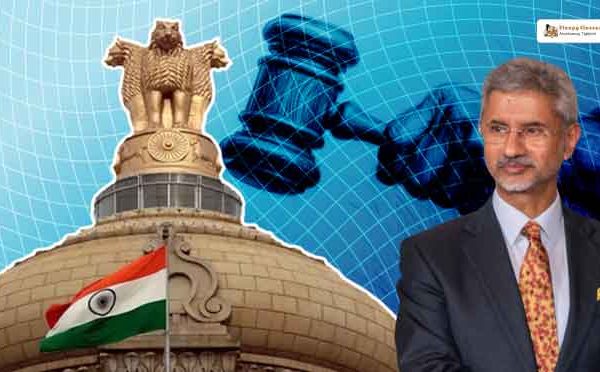Preparing for the UPSC exam can be challenging, especially when it comes to topics like Environment and Ecology. This article breaks down the syllabus into simple, easy-to-understand sections. Whether you’re just starting your preparation or looking to brush up on specific areas, this comprehensive guide will help you grasp essential concepts and stay on track.
Key Takeaways
- Understanding the basics of ecosystems, including biotic and abiotic factors, is crucial.
- Biodiversity is vital for ecosystem health, and there are various strategies for its conservation.
- Climate change has significant impacts on weather patterns, and there are both mitigation and adaptation strategies to address it.
- Pollution comes in many forms, such as air, water, and soil pollution, each with unique challenges.
- India has several key environmental laws and initiatives, and the judiciary plays an important role in their enforcement.
Understanding the Basics of Environment and Ecology
Components of the Ecosystem
An ecosystem is made up of living and non-living things that interact with each other. Plants, animals, and microorganisms are the living parts, while water, air, and minerals are the non-living parts. These components work together to create a balanced environment.
Biotic and Abiotic Factors
Biotic factors are the living parts of an ecosystem, like plants and animals. Abiotic factors are the non-living parts, such as sunlight, temperature, and soil. Both types of factors are essential for the survival of organisms in an ecosystem.
Levels of Organization in Ecology
Ecology studies different levels of organization, from individual organisms to the entire biosphere. These levels include:
- Organism: A single living thing.
- Population: A group of the same species living in an area.
- Community: Different species living together in one place.
- Ecosystem: A community plus its abiotic environment.
- Biosphere: All ecosystems on Earth.
Understanding these levels helps us see how life is interconnected and how changes in one part can affect the whole system.
Biodiversity: Importance and Conservation
Types of Biodiversity
Biodiversity includes different types such as genetic, species, and ecosystem diversity. Genetic diversity refers to the variety of genes within a species. Species diversity is the variety of species within a habitat or a region. Ecosystem diversity is the variety of ecosystems in a particular area. Each type of biodiversity plays a crucial role in maintaining the balance of nature.
Threats to Biodiversity
Biodiversity faces several threats, including habitat loss, pollution, climate change, and invasive species. Habitat loss occurs when natural habitats are destroyed for human activities like farming and urban development. Pollution from chemicals and waste harms many species. Climate change affects weather patterns and habitats, making it hard for some species to survive. Invasive species are non-native organisms that outcompete native species for resources.
Conservation Strategies
Conservation strategies aim to protect and preserve biodiversity. These strategies include in-situ and ex-situ conservation. In-situ conservation involves protecting species in their natural habitats, such as national parks and wildlife sanctuaries. Ex-situ conservation involves protecting species outside their natural habitats, like in zoos or botanical gardens. Other strategies include creating eco-sensitive areas, identifying ecological hotspots, and implementing national guidelines and international agreements.
Protecting biodiversity is essential for the health of our planet and the well-being of all living organisms.
Climate Change: Causes and Impacts
Greenhouse Gases and Global Warming
Greenhouse gases like carbon dioxide and methane trap heat in the atmosphere, leading to global warming. This warming affects weather patterns and sea levels. Human activities, such as burning fossil fuels and deforestation, increase these gases in the atmosphere.
Impacts on Weather Patterns
Climate change alters weather patterns, causing more extreme events like hurricanes, droughts, and heavy rainfall. These changes can disrupt agriculture, water supply, and even human health.
Mitigation and Adaptation Strategies
To combat climate change, we need both mitigation and adaptation strategies. Mitigation involves reducing greenhouse gas emissions, while adaptation means adjusting to the changes already happening. Some strategies include using renewable energy, improving energy efficiency, and developing climate-resilient infrastructure.
Climate change is a global challenge that requires immediate and sustained action from all countries. Working together, we can create a more sustainable and resilient future.
Pollution and Its Types
Pollution is a major issue affecting our environment and health. It comes in various forms, each with its own causes and effects. Understanding these types can help us take better care of our planet.
Environmental Policies and Legislation in India
India has a range of laws and policies to protect the environment. These laws aim to balance development with environmental conservation. Environmental law in India is mainly governed by the Environment Protection Act, 1986.
International Environmental Agreements
Kyoto Protocol
The Kyoto Protocol is a significant international treaty aimed at reducing greenhouse gas emissions. It was adopted in 1997 and came into force in 2005. The protocol sets binding targets for 37 industrialized countries and the European community for reducing greenhouse gas emissions. These targets are aimed at combating global warming. The protocol is based on the principle of common but differentiated responsibilities, recognizing that developed countries are primarily responsible for the current high levels of greenhouse gases in the atmosphere.
Paris Agreement
The Paris Agreement is a landmark accord that was adopted in 2015 during the 21st Conference of the Parties (COP21) to the United Nations Framework Convention on Climate Change (UNFCCC). The agreement aims to limit global warming to well below 2 degrees Celsius above pre-industrial levels, with efforts to limit the temperature increase to 1.5 degrees Celsius. Countries are required to set their own nationally determined contributions (NDCs) and to strengthen these efforts in the years ahead. The agreement also provides a framework for financial, technical, and capacity-building support to those countries that need it.
Convention on Biological Diversity
The Convention on Biological Diversity (CBD) is an international treaty that was adopted during the Earth Summit in Rio de Janeiro in 1992. The CBD has three main goals: the conservation of biological diversity, the sustainable use of its components, and the fair and equitable sharing of benefits arising from genetic resources. The convention is a key instrument for promoting sustainable development and ensuring that biological resources are conserved and used sustainably.
The conventions and protocols are tools for promoting cooperation and the development of international environmental law and actions.
Sustainable Development and Its Goals
Sustainable development is about meeting our needs without harming the ability of future generations to meet theirs. It focuses on balancing different needs against an awareness of environmental, social, and economic limitations. The idea is to ensure a better quality of life for everyone, now and in the future.
The United Nations has set 17 Sustainable Development Goals (SDGs) as part of the 2030 Agenda for Sustainable Development. These goals aim to end poverty, protect the planet, and ensure prosperity for all. Each goal has specific targets to be achieved over the next 15 years. The SDGs serve as a compass for aligning countries’ plans with their global commitments.
Implementing sustainable development goals is not without challenges. These include lack of funding, political instability, and insufficient data for tracking progress. Additionally, there is often a gap between policy and practice, making it hard to achieve the desired outcomes.
Sustainable development requires a collective effort from governments, businesses, and individuals to be truly effective.
Ecological Footprint and Resource Management
Measuring Ecological Footprint
The ecological footprint (EF) estimates the biologically productive land and sea area needed to provide the renewable resources that a population consumes and to absorb the waste it generates. Understanding our EF helps us see how much we use compared to what Earth can renew. This measure is crucial for planning sustainable living.
Resource Conservation Techniques
Resource conservation involves using resources more efficiently and responsibly. Some key techniques include:
- Recycling: Turning waste materials into new products.
- Water Conservation: Using water-saving devices and fixing leaks.
- Energy Efficiency: Using energy-saving appliances and light bulbs.
Sustainable Resource Management
Sustainable resource management ensures that resources are used in a way that meets current needs without compromising future generations. This involves:
- Planning: Creating strategies for long-term resource use.
- Monitoring: Keeping track of resource use and its impacts.
- Adapting: Changing practices based on monitoring results.
Sustainable resource management is essential for maintaining the balance between human needs and environmental health.
Role of NGOs and Civil Society in Environmental Protection
Non-Governmental Organizations (NGOs) and civil society play a crucial role in protecting the environment. They work at various levels, from local communities to global platforms, to address environmental issues and promote sustainable practices. Their efforts are vital in raising awareness, influencing policies, and implementing conservation projects.
Disaster Management and Environmental Impact Assessment
Natural disasters come in many forms, such as earthquakes, floods, and hurricanes. Each type has its own causes and effects. Understanding these disasters helps in planning and preparing for them.
Preparedness means getting ready before a disaster happens. This includes making emergency plans and having supplies ready. Mitigation involves actions to reduce the damage, like building stronger homes or creating barriers against floods.
Environmental Impact Assessment (EIA) is a method to check the possible environmental consequences of a proposed project or development. The EIA process includes several steps:
- Screening: Deciding if a project needs an EIA.
- Scoping: Identifying which impacts to study.
- Impact Analysis: Studying the potential effects.
- Mitigation: Finding ways to reduce negative impacts.
- Reporting: Writing an EIA report.
- Review: Checking the report for accuracy.
- Decision-making: Approving or rejecting the project.
- Monitoring: Ensuring compliance with EIA recommendations.
The EIA process is crucial for sustainable development. It helps in making informed decisions that balance development and environmental protection.
Environmental Impact Assessment (EIA) is essential for protecting our environment from harmful projects.
Renewable Energy Sources and Their Potential
Renewable energy has become a cornerstone of modern energy policy, driven by the need to mitigate climate change and reduce dependency on fossil fuels. There are several types of renewable energy sources, including solar, wind, hydro, geothermal, and biomass. Each of these sources has unique benefits and challenges, making them suitable for different applications and regions.
Renewable energy sources offer numerous benefits, such as reducing greenhouse gas emissions, decreasing air pollution, and providing a sustainable supply of energy. However, they also come with challenges, including high initial costs, technological limitations, and the need for supportive government policies. Balancing these benefits and challenges is crucial for the successful implementation of renewable energy projects.
Governments around the world have implemented various policies to promote the use of renewable energy. In India, initiatives like the National Solar Mission and the National Wind-Solar Hybrid Policy aim to increase the share of renewable energy in the country’s energy mix. These policies provide financial incentives, subsidies, and regulatory support to encourage the adoption of renewable energy technologies.
The rise and impact of renewable energy are evident in the growing number of projects and investments in this sector. As technology advances and costs decrease, renewable energy is expected to play an even more significant role in the global energy landscape.
Current Affairs Related to Environment and Ecology
Recent Environmental Issues
In recent times, several environmental issues have come to the forefront. One of the most pressing concerns is the increase in greenhouse gases, which has led to global warming. This has caused severe weather changes, including more frequent and intense storms, droughts, and heatwaves. Another significant issue is deforestation, which not only affects biodiversity but also contributes to climate change. Plastic pollution is another major problem, affecting oceans and marine life.
Government Responses
The government has taken various steps to address these environmental challenges. For instance, the Union Minister for Environment, Forest, and Climate Change, Bhupender Yadav, announced the launch of Ideas4Life at IIT Delhi. This initiative aims to collect innovative ideas for sustainable living. Additionally, the government has implemented stricter regulations on industrial emissions and promoted the use of renewable energy sources.
Global Environmental Trends
Globally, there is a growing awareness of environmental issues. Countries are coming together to combat climate change through international agreements like the Paris Agreement. There is also a significant push towards sustainable development and the use of renewable energy. The focus is on reducing carbon footprints and promoting eco-friendly practices.
Staying updated with current environmental issues and government responses is crucial for understanding the broader impact on our planet and society.
Stay updated on the latest environmental and ecological issues affecting our world today. From climate change to wildlife conservation, these topics are more important than ever. Visit our website to learn more and join the conversation. Together, we can make a difference.
Conclusion
In conclusion, mastering the Environment and Ecology syllabus for the UPSC exam is crucial for any aspirant. This section not only covers significant topics that frequently appear in the exam but also helps in understanding current affairs better. By breaking down the syllabus into manageable parts and focusing on key areas, students can build a strong foundation. Remember, consistent study and staying updated with recent developments are key to excelling in this subject. With dedication and the right resources, you can confidently tackle the Environment and Ecology section and boost your overall UPSC preparation.
Frequently Asked Questions
What is the Environment and Ecology syllabus for UPSC?
The Environment and Ecology syllabus for UPSC covers topics like ecosystems, biodiversity, climate change, pollution, and sustainable development.
Why is biodiversity important?
Biodiversity is important because it helps maintain ecosystem balance, supports food security, and provides medicinal resources.
How does climate change affect weather patterns?
Climate change can lead to more extreme weather events, such as hurricanes, droughts, and heavy rainfall, affecting ecosystems and human life.
What are the main types of pollution?
The main types of pollution are air pollution, water pollution, and soil pollution.
What are some key environmental laws in India?
Key environmental laws in India include the Environment Protection Act, the Wildlife Protection Act, and the Forest Conservation Act.
What is the Kyoto Protocol?
The Kyoto Protocol is an international treaty that commits countries to reduce greenhouse gas emissions to combat climate change.
What are the UN Sustainable Development Goals?
The UN Sustainable Development Goals are a set of 17 goals aimed at ending poverty, protecting the planet, and ensuring prosperity for all by 2030.
How can we measure our ecological footprint?
We can measure our ecological footprint by calculating the amount of natural resources we use and comparing it to the Earth’s ability to regenerate those resources.





